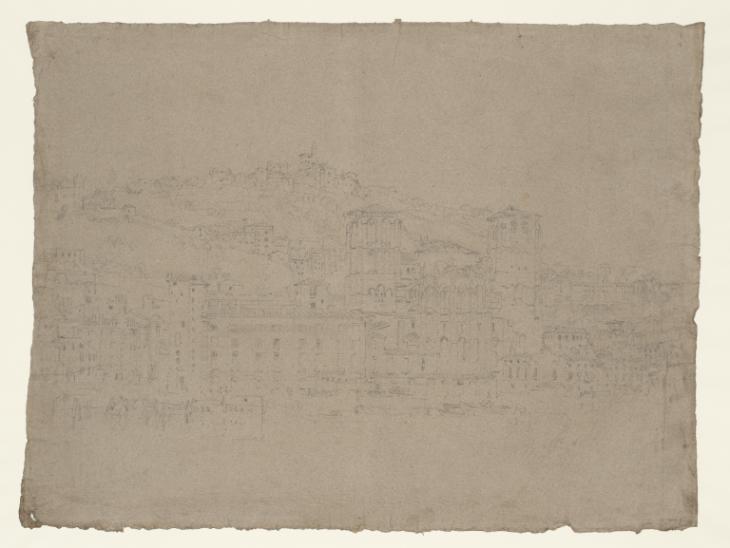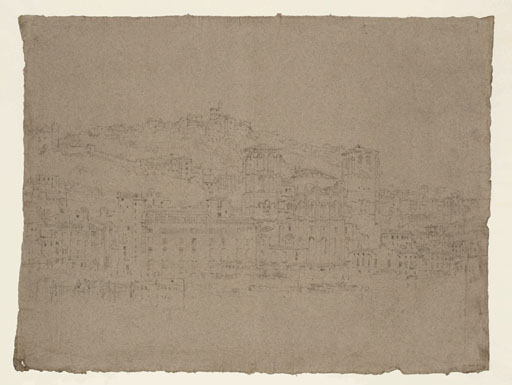Joseph Mallord William Turner Lyons from the Quai des Celestins 1802
Image 1 of 2
Joseph Mallord William Turner,
Lyons from the Quai des Celestins
1802
Joseph Mallord William Turner 1775–1851
Lyons from the Quai des Celestins 1802
D04890
Turner bequest LXXIX P
Turner bequest LXXIX P
Pencil on pale grey laid paper, 454 x 661 mm
Watermarked ‘D L’ in monogram and countermarked ‘Buges’
Stamped in black ‘LXXIX P’ bottom right
Watermarked ‘D L’ in monogram and countermarked ‘Buges’
Stamped in black ‘LXXIX P’ bottom right
Accepted by the nation as part of the Turner Bequest 2012
Exhibition history
1989
Turner: The Second Decade: Watercolours and Drawings from the Turner Bequest 1800–1810, Tate Gallery, London, January–March 1989 (9).
1990
Turner’s Papers: A Study of the Manufacture, Selection and Use of his Drawing Papers 1787–1820, Tate Gallery, London, October 1990–January 1991 (35).
References
1909
A.J. Finberg, A Complete Inventory of the Drawings of the Turner Bequest, London 1909, vol.I, p.211, LXXIX P, as ‘City beside a Lake’.
1981
Lindsay Stainton, in Maurice Guillaud and others, Turner en France: aquarelles, peintures, dessins, gravures, carnets de croquis / Turner in France: Watercolours, Paintings, Drawings, Engravings, Sketchbooks, exhibition catalogue, Centre Culturel du Marais, Paris 1981, p.82.
1989
Robert Upstone, Turner: The Second Decade: Watercolours and Drawings from the Turner Bequest 1800–1810, exhibition catalogue, Tate Gallery, London 1989, p.22 reproduced.
1990
Peter Bower, Turner’s Papers: A Study of the Manufacture, Selection and Use of his Drawing Papers 1787–1820, exhibition catalogue, Tate Gallery, London 1990, pp.86–7.
1992
David Hill, Turner in the Alps: The Journey through France & Switzerland in 1802, London 1992, pp.29–30 reproduced, 169.
This sketch was made on one of the large loose sheets of French paper that Turner took with him to France and Switzerland in 1802.
Turner spent three days in Lyons in late July that year, and, as he later told Joseph Farington, thought ‘the views of the [River] Saone are fine’ and the city’s buildings ‘better than those of Edinburgh, but there is nothing so good as Edinburgh Castle’.1 He also complained that the city was ‘very dear’ and ‘not settled enough’ to allow him to do much drawing.2 However, this large study was as elaborate as he made of any French subject in 1802. From the Quai des Celestins on the eastern bank of the River Saône, it looks across the river to the Cathedral of St Jean, built in the twelfth century but recently damaged in the Revolution (a further sketch of the building is on the verso). To its left is the old choir school, the Manécanterie, and behind it the Fourvière Hill, the site of the original Roman settlement.
Drawn carefully, with much detail, the study shows Turner’s close interest in architecture as an art form in its own right. It might be compared with his view of the Swiss town of Thun from the St Gothard and Mont Blanc sketchbook (Tate D04622; Turner Bequest LXXV 30).
There are other sketches of Lyons in the smaller France, Savoy, Piedmont sketchbook (Tate D04428–D04432; Turner Bequest LXXIII 35a–38).
Technical notes:
Peter Bower has identified the maker of the paper as Leorier Delisle of Buges Mill, Montargis, France. The sheet, of Grand Carré size, is watermarked with a D L monogram and countermarked ‘Buges’. This paper is different from the other French sheets bought in 1802, mostly in Paris. Bower observes that its ‘particular grey’ can be attributed to the mixture of white linen, blue and red rags and rope hemp likely to have been used in its manufacture. The hemp and linen would have been bleached, revealing the shives that fleck the sheet. During the Revolution, the Buges mill had pioneered the chemical bleaching of fibres, in an effort to produce fine white papers despite the severe shortage of good rags.1
David Blayney Brown
January 2012
How to cite
David Blayney Brown, ‘Lyons from the Quai des Celestins 1802 by Joseph Mallord William Turner’, catalogue entry, January 2012, in David Blayney Brown (ed.), J.M.W. Turner: Sketchbooks, Drawings and Watercolours, Tate Research Publication, September 2014, https://www


